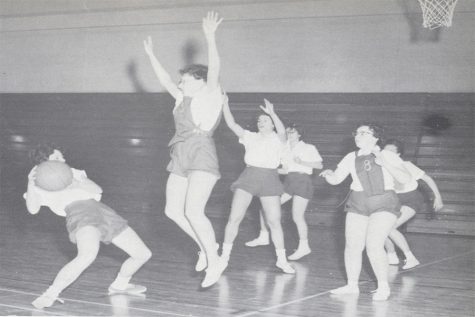The Evolution of a Student: Baby Boomers
January 17, 2017
The following is the first part of a three-part series of stories about the evolution of a Sheboygan South student. From the opening of South High School to now, many things have changed—the Vietnam War began and ended, Dr. Martin Luther King Jr. gave his famous “I Have a Dream” speech, the Panama Canal was opened, technology exploded, and America elected their first African American president. However, many things have stayed the same. Students are still plagued by the same pressures—homework, athletics, career paths, and many more still cause students stress. The purpose of this three-part series is to explore the similarities and differences of each generation of Redwings and Redmen from the opening of South High to the present.
From 1961 to approximately 1980, the grandparents of current high school students attended South High. John F. Kennedy (1961-1963), Lyndon B. Johnson (1963-1969), Richard Nixon (1969-1974), Gerald Ford (1974-1977), and Jimmy Carter (1977-1981) served as President of the United States, the first people landed on the moon (1969), Earth Day was celebrated for the first time (1970), and Microsoft was founded (1975). For South’s first two decades as a school, South’s mascot was the Redmen, but that wasn’t the only difference. Athletics were drastically different, and societal norms have changed greatly. Academically, however, not much has changed.
“Our teachers expected hard work and our best, but our best was determined by the individual,” explained Mr. Jamie Berlin, Class of 1978. Much like today, teachers didn’t want students’ potential to be wasted–hard work was emphasized greatly.
However, one major difference was the lack of emphasis on college.
“Because of my test scores, I was approached about being put on the ‘college track.’ Once I declined the offer, however, I was never approached again, and remained in the ‘business track’,” stated Mrs. Ann Specht née Bogenschuetz, Class of 1970. In the 60s and 70s, you were put either on the “college track,” the “business track,” or the “shop track.” Those on the “college track” were placed in college preparatory classes and set for a career in which a college degree is necessary. Those on the “business track” were in business classes and were set for business careers, like a secretary or an accountant. Those on the “shop track” were in technology education (tech ed) classes, and were set for a career like an electrician or a mechanic. Once a student was placed on one such “track,” you only took classes within that area.
“I had a lot of friends in tech ed classes, and I tried once to take a shop class,” said Berlin. “My counselor called me down and told me I couldn’t take that class because I was going to college.” This was one of only two interactions between Berlin and his counselor during his high school career.

Athletically, many things differed from the early years of SHS to the present, the biggest contrast being the lack of girls’ sports. Instead of participating in sports affiliated with South High, as the boys did, girls participated in sports through the Girls Athletic Association (GAA). As described in the 1962 Lake Breeze yearbook, “the chief aim of the Girls Athletic Association [was] to provide advanced training in physical education activities.” The activities run by the GAA were varied, but very different from today’s WIAA offerings.
“I did gymnastics and though we were able to host other schools, we were not able to charge admission,” stated Specht née Bogenschuetz, “I don’t think we ever had a spectator–the public didn’t know about it.” According to the 1964 Lake Breeze yearbook, besides gymnastics, the GAA also offered badminton, dancing, basketball, bowling, swimming, tumbling, and volleyball (1964 Lake Breeze yearbook).
The boys, on the other hand, could participate in pretty much the same sports as are offered now.
“Title IX was just coming into effect as I was entering high school,” said Ms. Linda Badtke, Class of 1976. As described by the United States Department of Justice, Title IX, a “comprehensive federal law that prohibits discrimination on the basis of sex in any federally funded education program or activity,” was passed in 1972 and opened up South High School’s extracurriculars to girls as well as boys.
As Title IX and other pushes for gender equality set in nationwide, South adjusted accordingly. Young women’s newfound ability to participate in their high school’s athletics corresponded to a bigger societal movement for gender equality in the workforce.
“Back then, you graduated, you got married, you had kids. Women did not work after they had kids, we stayed home with them,” Specht née Bogenschuetz explained. However, soon after Specht née Bogenschuetz graduated, things began to change.
“When I was an underclassman, girls were expected to get married and have kids as soon as possible,” explained Badtke, “but by my senior year, more jobs had opened up–especially for women–in science and in math.” Starting a family was no longer the main focus of young adult women as the world of possibilities for them expanded.
College became more available to all students, jobs opened up–for women and men–and athletic options in high school broadened. As possibilities for young men and women grew and changed, this generation of Redmen grew up and became the parents of the next generation of Redwings.

Mike Trimberger • Jan 18, 2017 at 8:53 am
Natalie,
Great first piece. I learned a couple new things from piece number one. I am looking forward to reading the next two. Keep up the great work.
Mr. Trimberger
Ed Clabots • Jan 17, 2017 at 10:12 pm
Two comments:
Great to see your story!
You included the Panama Canal. That opened in 1914. The rest of the story seemed to imply that your story starts with the opening of the building at South High in, was it 1960?